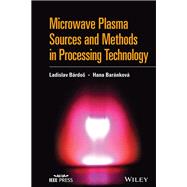
Microwave Plasma Sources and Methods in Processing Technology
by Bardos, Ladislav; Barankova, HanaBuy New
Rent Textbook
Rent Digital
Used Textbook
We're Sorry
Sold Out
How Marketplace Works:
- This item is offered by an independent seller and not shipped from our warehouse
- Item details like edition and cover design may differ from our description; see seller's comments before ordering.
- Sellers much confirm and ship within two business days; otherwise, the order will be cancelled and refunded.
- Marketplace purchases cannot be returned to eCampus.com. Contact the seller directly for inquiries; if no response within two days, contact customer service.
- Additional shipping costs apply to Marketplace purchases. Review shipping costs at checkout.
Summary
Author Biography
Ladislav Bardos, PhD, is Professor at the Department of Electrical Engineering at Uppsala University. He received his PhD from the Institute of Plasma Physics at the Czech Academy of Sciences in 1978 and DrSc from the Charles University Prague in 1995. He was awarded the Plasma Physics Innovation Prize 2019 by the European Physical Society.
Hana Barankova is a Professor at the Department of Electrical Engineering, Uppsala University. She received her PhD from the Institute of Radio Engineering and Electronics at the Czech Academy of Sciences in 1981. She was awarded the Plasma Physics Innovation Prize 2019 by the European Physical Society. She is Secretary of the Board of Directors at the Society of Vacuum Coaters in the US.
Table of Contents
Foreword from the Authors ix
1 Basic Principles and Components in the Microwave Techniques and Power Systems 1
1.1 History in Brief – From Alternating Current to Electromagnetic Waves and to Microwaves 1
1.2 Microwave Generators 3
1.3 Waveguides and Electromagnetic Modes in Wave Propagation 5
1.3.1 The Cut-off Frequency and the Wavelength in Waveguides 7
1.3.2 Waveguides Filled by Dielectrics 9
1.3.3 Wave Impedance and Standing Waves in Waveguides 10
1.3.4 Coaxial Transmission Lines 12
1.3.5 Microwave Resonators 14
1.4 Waveguide Power Lines 14
1.4.1 Magnetron Tube Microwave Generator 16
1.4.2 Microwave Insulators 16
1.4.3 Impedance Tuners 17
1.4.4 Directional Couplers 19
1.4.5 Passive Waveguide Components – Bends, Flanges, Vacuum Windows 20
1.4.6 Tapered Waveguides and Waveguide Transformers 22
1.4.7 Power Loads and Load Tuners 23
1.4.8 Waveguide Phase Shifters 25
1.4.9 Waveguide Shorting Plungers 25
1.4.10 Coupling from Rectangular to Circular Waveguide: Resonant Cavities for Generation of Plasma 26
1.5 Microwave Oven – A Most Common Microwave Power Device 28
References 33
2 Gas Discharge Plasmas 37
2.1 Basic Understanding of the Gas Discharge Plasmas 37
2.2 Generation of the Plasma, Townsend Coefficients, Paschen Curve 40
2.3 Generation of the Plasma by AC Power, Plasma Frequency, Cut-off Density 43
2.4 Space-charge Sheaths at Different Frequencies of the Incident Power 50
2.5 Classification of Gas Discharge Plasmas, Effects of Gas Pressure, Microwave Generation of Plasmas 55
2.5.1 Classification of Gas Discharge Plasmas 55
2.5.2 Effects of the Gas Pressure on Particle Collisions in the Plasma 58
2.5.3 Microwave Generation of Plasmas 61
References 64
3 Interactions of Plasmas with Solids and Gases 67
3.1 Plasma Processing, PVD, and PE CVD 67
3.2 Sputtering, Evaporation, Dry Etching, Cleaning, and Oxidation of Surfaces 72
3.3 Particle Transport in Plasma Processing and Effects of Gas Pressure 75
3.3.1 Movements of Neutral Particles 76
3.3.2 Movements of Charged Particles 77
3.3 Effect of the Gas Pressure on the Plasma Processing 79
3.4 Afterglow and Decaying Plasma Processing 81
References 83
4 Microwave Plasma Systems for Plasma Processing at Reduced Pressures 85
4.1 Waveguide-Generated Isotropic and Magnetoactive Microwave Plasmas 85
4.1.1 Waveguide-Generated Isotropic Microwave Oxygen Plasma for Silicon Oxidation 87
4.1.2 ECR and Higher Induction Magnetized Plasma Systems for Silicon Oxidation 93
4.2 PE CVD of Silicon Nitride Films in the Far Afterglow 105
4.3 Microwave Plasma Jets for PE CVD of Films 111
4.3.1 Deposition of Carbon Nitride Films 115
4.3.2 Surfajet Plasma Parameters and an Arrangement for Expanding the Plasma Diameter 119
4.4 Hybrid Microwave Plasma System with Magnetized Hollow Cathode 122
References 129
5 Microwave Plasma Systems at Atmospheric and Higher Pressures 135
5.1 Features of the Atmospheric Plasma and Cold Atmospheric Plasma (CAP) Sources 136
5.2 Atmospheric Microwave Plasma Sources Assisted by Hollow Cathodes 140
5.2.1 Applications of the H-HEAD Plasma Source in Surface Treatments 144
5.3 Microwave Treatment of Diesel Exhaust 151
5.4 Microwave Plasma in Liquids 154
5.5 Microwave Plasma Interactions with Flames 157
5.6 Microwave Plasmas at Very High Pressures 161
References 162
6 New Applications and Trends in the Microwave Plasmas 169
References 176
7 Appendices 181
7.1 List of Symbols and Abbreviations 181
7.2 Constants and Numbers 188
Index 189
An electronic version of this book is available through VitalSource.
This book is viewable on PC, Mac, iPhone, iPad, iPod Touch, and most smartphones.
By purchasing, you will be able to view this book online, as well as download it, for the chosen number of days.
Digital License
You are licensing a digital product for a set duration. Durations are set forth in the product description, with "Lifetime" typically meaning five (5) years of online access and permanent download to a supported device. All licenses are non-transferable.
More details can be found here.
A downloadable version of this book is available through the eCampus Reader or compatible Adobe readers.
Applications are available on iOS, Android, PC, Mac, and Windows Mobile platforms.
Please view the compatibility matrix prior to purchase.
